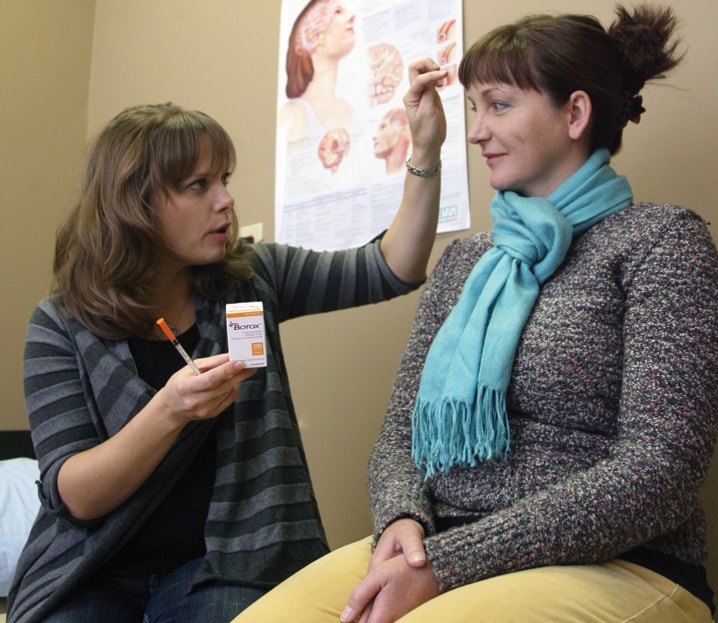A splitting headache is both figure of speech and harsh reality for Audra Sinclair.
“It’s like an icepick in the back of your head, a constant, nagging pain that never really subsides,” says the Red Deer migraine sufferer.
Unlike tension headaches, a migraine’s throbbing pain can last up to 72 hours, produce nausea and vomiting and come with sensitivity to light, sound and even smell.
“You have like the nose of a dog and any smell will bother you,” said Sinclair, deemed chronic since she gets attacks 15 days or more per month and they last at least four hours.
The World Health Organization says living with migraines is underestimated, under recognized and undertreated.
It’s partnered with the World Headache Alliance, International Headache Society and European Headache Federation in Lifting The Burden, a global campaign to understand migraines better and so sufferers can get more health care priority and access.
WHO contends repeated headaches — and fear of the next one — damage employment and family and social life.
“When I have one, I can’t work, I can’t drive and it might last for days,” said Sinclair, who’s recently started a Facebook group for sufferers called Central Alberta Migraine Support.
Women are three times more likely than men to suffer chronic migraines due to hormonal changes starting at menstruation, although lessening at menopause, said Dr. Jennifer Bestard, a Red Deer physician specializing in migraines.
“Migraine headaches make people feel very helpless,” said Bestard, who has about 200 migraine patients. Migraines begin in the brain stem atop the spinal cord, she says.
Triggers include caffeine that constrict the vessels to the brain that prevent pain and stress “around holidays or birthdays when there’s extra activity,” said Bestard, as are poor sleep habits.
“Good sleep hygiene is vital and when you get up is more important than when you go to bed. The body craves routine.”
Barometric pressure changes also wreak havoc.
“If we go from -20C to 5C, if they predict that, I plan,” said Sinclair, adding summer is also bad because of sudden storms.
Ironically, pain medication overuse, of even over-the-counter drugs, can bring on rebound headaches.
“People have to come off the daily medication and they don’t like it,” said Bestard, adding narcotics are the worst.
Migraine onset is usually signalled. Auras, kaleidoscopic lights perhaps accompanied by vision loss, pin and needle sensations in limbs and speech problems occur prior to an attack. Early symptoms occur a day or so before an attack and can include depression, diarrhea, hyperactivity and irritability.
“People just don’t feel right and a lot more get it than auras,” said Bestard.
Drugs known as triptans, which narrow blood vessels dilated during migraines, treat pain yet provide no prevention.
Enter the wrinkle-reducing drug Botox.
Onabotulinumtoxin A was approved by Health Canada late last year for migraine treatment.
Bestard, who’s done a headache and neuropathic pain fellowship, is the only Alberta doctor in a national pilot project to chart its effectiveness for the drug’s maker Allergan.
“It acts to block messages from nerves to muscles, decreasing the severity of headaches.”
Nearly 200 units are injected in 32 sites in the head’s front, back and sides, plus the neck and across the shoulders. Injections are repeated about every three months.
“About 70 per cent of patients will respond in a week or so,” said Bestard.
Sinclair’s three treatments have “nipped in the bud” her migraines.
“This was my best summer ever. I did a lot of things I wouldn’t normally do,” she said, adding she hasn’t been to hospital — after averaging a trip every few months for years — since getting Botox.
Treatment costs about $600 per injection set, economical considering some triptan pills are $20 each, said Bestard.
Some insurance companies cover the treatments, but only with migraine history proof and after exhausting other treatments.
“They see it as the last line of defence.”
Only medical — and not cosmetic — Botox treatments are covered.
“We had a patient who paid $1,200 for a cosmetic treatment and it didn’t work because it wasn’t in the migraine pattern.”
The injections are approved for patients suffering from chronic migraines provided they are over 18 and under 65, which matches the Health Canada guidelines. The coverage has been in place since November 2011 and other provinces follow the same guidelines.
Regardless of Botox’s success, Bestard said a plan is the best way to treat migraines. Her patients keep daily journals to determine patterns.
“For instance, is it a three-day headache or one headache daily over three days?”
Whatever the treatment, reducing headache frequency and intensity is the goal.
“Most people say if they can get a decrease, they get their lives back.”
rfiedler@www.reddeeradvocate.com
